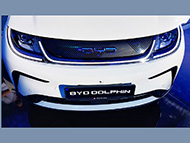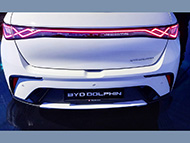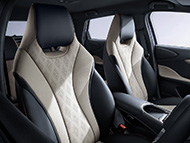By Lee Pang Seng
LOOKS like EVs (electric vehicles) are now coming within the reach of more buyers with the latest model from BYD (Build Your Dreams), the Dolphin. No, BYD is not selling you a fish but a neat hatchback that is as spacious as it is forward looking.
Why the name Dolphin? Well, BYD says this model’s styling is inspired by ‘the beauty and grace’ of the Dolphin. It features an ‘Oceanic Aesthetic’ design concept that has the body projecting flowing contours, complemented by continuous LED (light emitting diode) headlamps across the grille, geometric taillamp styling and fin-shaped grab handles, among other items.
This fully electric vehicle is equipped with BYD’s ‘iconic’ technological advancements such as the Blade battery (which BYD hails as a revolutionary innovation that enables battery safety and increased energy density); e-Platform 3.0 described as an exclusive technology platform for highly efficient and intelligent vehicles; high-efficiency energy-saving heat pump system and the world’s first mass-produced 8-in-1 electric powertrain that is said to optimise space utilisation and energy efficiency.
As a hatchback, it would be interesting to compare it against some ICE (internal combustion engine) rivals such as the Toyota Yaris and Honda City Hatchback. While these rivals carry cheaper price tags, dimensionally all three are pretty similar. However, the Dolphin has the longest wheelbase at 2700mm and is taller too at 1570mm.
You could feel the roomier headroom that the Dolphin offers as well as the better legroom for rear passengers. The luggage area provides 345 litres of space and with the 60:40 split rear seatrests that could be folded down, that space could be quadrupled to 1310 litres to accommodate more items.
While the Dolphin comes with a 12.8-inch ‘intelligent’ rotating touchscreen located at the centre of the dashboard (similar to that in the BYD Atto 3 Crossover), the instrument panel the driver relies for speed and energy consumption information is puny by comparison. Maybe, BYD figured that you don’t need a bigger instrument panel without a tachometer (which indicates engine speed in ICE cars) but somehow, there is a lack of dimensional proportion with the big touchscreen nearby.
There are two model variants available; the Dynamic Standard and Premium Extended range with power output as the main differentiator. The Dynamic Standard has a 44.9kWh battery and the Premium Extended comes equipped with a more powerful 60.48kWh battery to drive the permanent magnet synchronous motor.
Given that scenario, the Dynamic Standard variant delivers a maximum power of 70kW (95hp) and 180Nm that is good for 0-100km/h sprints in 12.3 seconds. Its range is 340km (WTLP or Worldwide Harmonised Light Vehicles Test Procedure that is seen as a more realistic standard).
The Premium Extended has more punch on hand, thanks to the higher power battery, with double the power at 150kW (204hp) and 310Nm. Naturally, it sprints from rest to 100km/h a lot faster at 7.0 seconds. Despite that, it has a longer driving range at 427km (WTLP). The electric power in both cars is used to drive the front wheels.
In suspension design, both variants have a MacPherson strut front but the Dynamic Standard has a torsion beam rear while the Premium Extended comes with multi-links. Likewise, the former has smaller alloy wheels and tyres (195/60 R16) and the latter a bigger combination of 205/50 R17.
Differences between the two include a higher power charging port for the Premium variant as well as dual stage pretensioner on the front seatbelts (just pretensioner for the Dynamic Standard), panoramic glass roof, mobile phone wireless charging, six-way power adjustment for the driver’s seat, ventilated front seats, to mention a few. The Premium Extended’s 80kW DC charging rate allows a 30-80 per cent charge in 30 minutes and it is longer for the Dynamic Standard’s 60kW charge system.
Brief drive
A BRIEF drive covering about 15 kilometres was arranged during the Dolphin launch at 1Utama and we got into the nearest model, which was the Dynamic Standard. We couldn’t tell the difference as there was no clear model differentiation in model badging. Similarly, we didn’t check the model specifications beforehand that would have allowed us to focus on the tyre size as a guide.
Nevertheless, we settled down to what we had before us. That was when we noted the puny instrument panel behind the steering wheel. There was also the unusual gear selector; a sort of flick or roll control on the centre dash panel that is located nearest to the driver. Flick up for Reverse and flick down to Drive. Press it in centre for a while and it goes into Neutral. The handbrake button is on the centre console and you roll it forward or backward to apply or release the handbrake.
As is normal for an EV, the strong and immediate take-off was enjoyed due to the immediate torque coming into play to drive the front wheels. With only 180Nm at our foot, we couldn’t do what those driving the 310Nm Premium Extended models were doing – spinning the front wheels on even stronger take-offs resulting in some tyre squeals.
Speed build-up on the move was pretty good but then again, we were losing out quite clearly on pace to the more powerful Premium Dolphins. Instead of a tachometer, you could check how much electricity you are draining from the battery during acceleration. We noted electricity above 60kW being used while accelerating hard (meaning our foot was pressing the pedal almost to the floor). If you want maximum driving range, you could use that as a guide so that you could enjoy city driving at a gentler pace. We started with more than 380km range and ended the drive with about 340km after 15km, due to the robust driving.
Body aerodynamics appeared good as we heard little of the wind noise during the few short bursts of speed on the highways along the route. Typical to EVs, what we heard more of was the intrusion of road noise that varied according to the respective tarmac surfaces. Even so, the noise level was bearable and certainly didn’t drown out the radio music we had on.
The suspension system felt reasonably well sorted out as we could take to the few bends and corners with fair aggro despite the somewhat heavy traffic conditions. Body roll seemed well checked and the 195/60 R16 Linglong EcoMaster tyres absorbed the few bumps and road ripples that we came across rather nicely for a comfortable ride.
Dolphin outlook
The Dolphin Dynamic Standard has a starting price of RM99,900 leading to an on-the road price of RM100,530 without insurance. It loses slightly to the Neta V that was launched recently. For the Premium Extended model, the price starts at RM124,900 resulting in an on-the-road price of RM125,510 without insurance.
Once the minimum price limit for imported EVs is removed by the government, hopefully in about two years’ time (so that others in the automotive industry could come up to par in EV development), you could expect EV prices to go even lower. As it were, the BYD Dolphin’s prices are definitely a lot more affordable than most of the EVs that are currently in the market.
Both Dolphin variants come with a six-year or 150,000km warranty while the battery is covered for eight years or 160,000km. BYD also offers a separate warranty of eight years or 150,000km for the electric motor and the respective paraphernalia, including the DC assembly and electric control assembly.
For the price, these Dolphin variants come with a full suite of active and safety features; some of these safety features are usually found only in the premium or flagship models in the ICE range. Our favourite is the 360-all round view that helped in parking the car.
Sime Darby Motors expects to sell 60 per cent of the BYD Dolphin range in the Klang Valley and 20 per cent respectively in the northern and southern region. Bookings are said to beyond expectations and delivery would start in August. What’s more, 12 more dealers would be added to the current nine to serve customers in a wider area. A new company would also be set up to look into providing more charging points for BYD vehicle owners; in this respect, it is also working with other companies to instal these charging stations over a wider area.
With this latest BYD model availability as an indication of what is to come not too far down the road, more prospective car owners might just consider EV motoring with the more competitive pricing. Yup, it would soon be time for many to go electric!




















